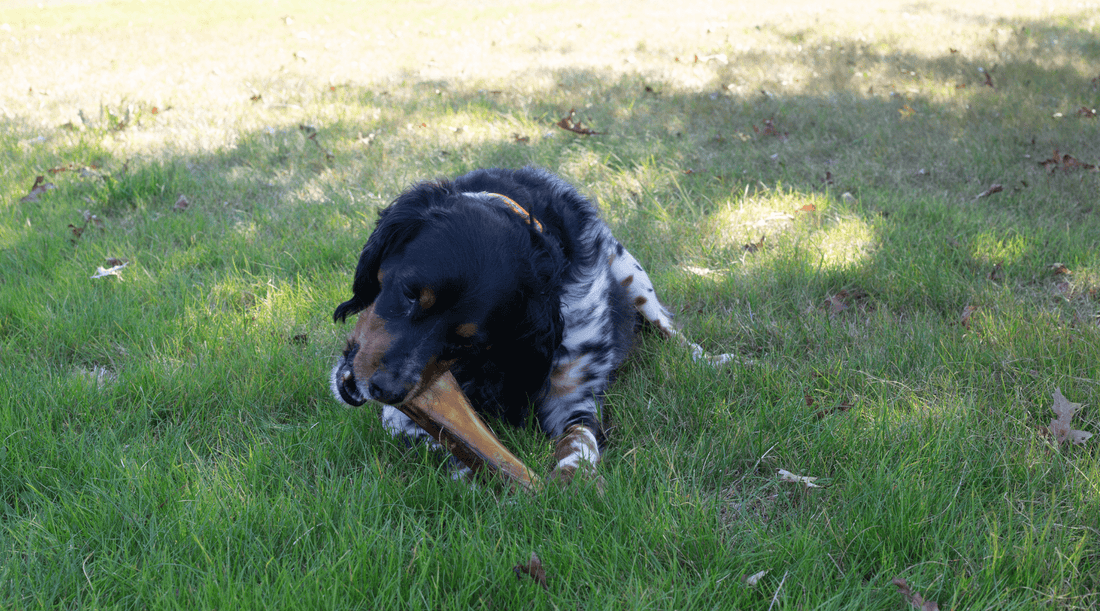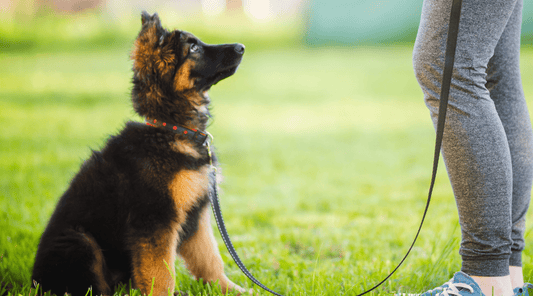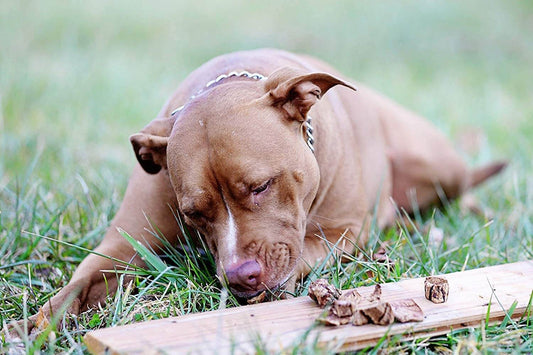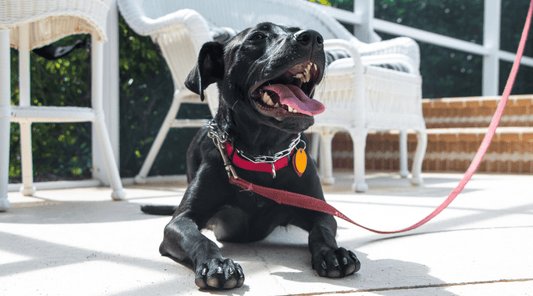
Why Do Dogs Like Chewing on Bones? Mystery Solved
Dawn Miller Feb 21, 20255 Minute ReadIf you've ever wondered why do dogs like chewing bones, you're certainly not alone. I get this question all the time as neighbors see my K9s chomping down on meaty marrow bones. In our house, dog bones don't just represent something fun to chew on. Dog bones support mental, physical, dental, and emotional health in dogs in so many ways.
So, last Saturday, around my dogs' regularly scheduled chew session, I opened the treat cabinet to realize we were down to our last dog bone. But I have 3 dogs. I almost panicked before remembering how fast I could get high-value, USA-made dog bones on Amazon.
What a relief! As a proud dog mom of 3 amazing rescues, here's why running out of dog bones made my heart race.
Why Do Dogs Like Chewing Bones? It's Instinct
Gnawing on a juicy marrow bone is a deeply rooted instinct for dogs. Their ancestral wolves chewed on bones to:
- Clean their teeth after a meal
- Strengthen their jaws, which is key to survival for a wild dog
- Alleviate boredom
- Get at that nutritious, sweet, and buttery bone marrow inside
- Because it's entertaining for the dog
When something is instinctive, dogs will do almost anything to meet their needs. My dogs get anxious, antsy, and bored when they don't have a dog bone to chew on at least a couple of times a week.
In the wild, wolves chew on sticks when they don't have access to bones.
Not as tasty or nutritious. But they do what they have to.
Dogs don't usually have access to sticks in homes, either. So, they often become destructive when they don't have bones to chew on. They might chew on sneakers or table legs. They may scratch up door frames, carpet, or wood floors. Sofa pillows often get shredded in the process.
These behaviors are natural. So, if you're asking why do dogs chew on things, it's just a dog trying to satisfy its instincts however it can.
Now that you know why, let's take a closer look at these benefits. Some of them are really exciting to me as a doting dog mom.
Benefits of Chewing Bones
Dental Health
Tartar and plaque build up on teeth over time. As they do, bacteria have better places to hide. So, the mouth becomes more bacterial and extra stinky. Don't tell my terrier Pixie I told you this. But her breath was a nightmare when I brought her home from the shelter.
Obviously, that was the least of my worries.
These bacteria produce an acid that destroys tooth enamel (causing tooth decay) and irritates the gums (leading to gingivitis).
Chewing on bones removes the plaque and tartar these bacteria rely on to multiply. Studies have shown that chewing on bones can reduce the bacteria count in dog mouths by 60-80%.
Mental Stimulation
Chewing provides dogs with mental exercise, helping to reduce anxiety and prevent destructive behaviors. It keeps their minds occupied and can be especially beneficial for high-energy breeds.
I think of marrow-filled bones as a more natural alternative to those dog puzzle toys. You should watch my lab mix, Bruno, chewing, licking, and flipping the bone around, trying to figure out how to get the bone marrow out.
He doesn't look frustrated. He seems to be having a lot of fun!
Nutritional Benefits
Bones, particularly grass-fed beef marrow bones, are rich in nutrients like calcium and phosphorus. They have loads of collagen protein, healthy fats, and glucosamine.
While these nutrients support multiple functions in overall dog health, they're vital for healthy bones, joints, skin, coat, heart, and brain—all critical systems I want to keep running at their best.
Help Distractible Dogs Concentrate
Little known benefit here. Chewing on bones can help hyper dogs by giving them an alternative outlet for excess energy. When trying to train a hyper, stubborn, or fearful dog, starting a consistent dog bone regimen can give you the edge you need to succeed.
As a bonus, dogs who get regular dog bones from their dog parents learn to trust them. It strengthens your bond, further improving their cooperativeness during training sessions.
To learn more about training hard-to-train pups, check out this Free 7-Day Dog Training Challenge!
Choosing the Best Bones for Dogs to Chew
Now, I mentioned that I get my bones on Amazon. But I don't just randomly choose a dog bone vendor. Some of these bones are old or come from countries that don't have the safety standards we do. I always buy dog bones from companies in the USA. These dog bones are from cattle born and raised in the USA.
I also look for grass-fed beef bones. Grass-fed beef is higher in omega-3 healthy fats and lower in saturated fat, which is better for dog health.
It's also important to distinguish between dairy cow and beef cattle bones. Many, many dog bones come from dairy cows. In fact, if they don't say otherwise, you can count on it.
Dairy cows produce milk for their whole adult life. This is tough work, and it depletes minerals from their bones. So, dairy cow bones are more brittle. They can crack and cause tears and intestinal blockages. Very dangerous!
I also look for slow-roasted bones on low heat to ensure safe bone density. Even aggressive chewers can enjoy real dog bones when they're prepared correctly.
K9 Connoisseur's marrow bones are an excellent choice. They sell only all-natural, single-ingredient dog bones and dog treats that satisfy my dog's chewing instinct while promoting dental health, mental health, and physical health.
Safety Tips for Dog Bone Chewing
Now that we've established why dogs like chewing bones, I have some quick safety tips for you.
- Get the Right Size - Beef dog bones can be very big for your Mastiffs and Great Danes, small for your Chihuahuas and Pomeranians, or somewhere in between. It's important to give big dogs bones larger than their head in one direction so they can't swallow it. And for little dogs, it may be cute to give them a massive Goliath bone. But they'll probably have more fun with some meaty riblets.
- Supervise - Even the safest dog bones out there could break. So, it's important not to let dogs chew bones unattended.
- Avoid Raw - The American Veterinary Medical Association recommends against raw food for dogs for safety reasons.
- Only 10% of the Diet - Dogs need balanced nutrition for complete dog health. For the most part, a veterinarian-approved kibble will provide that. So, it should be most of their diet. With that said, kibble can be lacking in omega-3 fats, heat-sensitive vitamins, collagen, and glucosamine. When you give your dog a bone, you're filling in these nutritional gaps.
- Never Give Your Dog Dinner Bones - Dinner bones like ribs or lamb chops have been cooked at too high temps and may splinter. Instead, always buy dog bones from a reliable dog bone vendor. It's no secret. I'll recommend K9 Connoisseur.
Available On:
Disclosure: This article may contain affiliate links, which means we may earn a small commission if you make a purchase through these links—at no extra cost to you. We only recommend products we trust and believe will benefit you and your K9.





